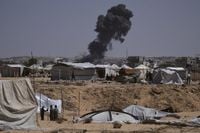On September 16, 2025, the world’s eyes turned once again to Gaza City as Israel launched a sweeping ground assault, vowing to crush Hamas in what it described as the largest and most decisive military operation yet in the battered Palestinian territory. The offensive, which Israeli officials dubbed the "main phase" of their campaign, marked a dramatic escalation in a conflict that has already devastated the region for nearly two years and left the fate of countless civilians hanging in the balance.
According to The Federal, the assault began with relentless bombardment and the movement of Israeli troops from the outskirts of Gaza City, following weeks of airstrikes and military buildup. Israeli Defence Minister Israel Katz didn’t mince words as the operation kicked off, declaring, "Gaza is burning." The sound of explosions echoed through the city’s ruins, while thousands of Palestinians—many clutching only a few belongings—fled in vehicles stacked with mattresses and hastily packed possessions, clogging the coastal road in a desperate bid to escape the violence.
The timing of Israel’s offensive was no accident. As reported by AFP, the move came just as international criticism of Israel’s conduct in the war, sparked by Hamas’s October 7, 2023 attack, was reaching new heights. In Israel itself, public pressure was mounting. Thousands, including anguished relatives of hostages still held by Palestinian fighters, had taken to the streets in recent weeks, demanding an end to the war and the safe return of their loved ones.
Yet, far from quelling the controversy, the new assault only intensified global scrutiny. On the very day the offensive began, independent experts commissioned by the United Nations Human Rights Council accused Israel of committing genocide in Gaza—a charge Israel swiftly rejected as "distorted and false." The accusation added fuel to a debate that has polarized governments and populations worldwide, with some nations denouncing Israel’s tactics at a recent summit but stopping short of any concrete action.
The human cost of the renewed fighting was immediate and harrowing. Palestinian hospitals reported at least 69 deaths from heavy strikes on Gaza City that Tuesday morning, including 22 children at Shifa Hospital alone, according to Dr. Rami Mhanna, a hospital official cited by AP. Dr. Mohamed Abu Selmiya, director of Shifa Hospital, described "a very tough night in Gaza," saying, "The bombing did not stop for a single moment." AP footage showed grieving women gathered at the hospital’s morgue, mourning relatives lost in the bombardment. Saud al-Sakani, whose daughter, son-in-law, and grandchildren perished when a strike flattened their home with about 40 people inside, wept over their bodies, crying, "An entire family! Many are still under the rubble."
For many Palestinians, the only option was flight. Ismail Zaydah, 39, told The Federal he fled from his home in Gaza City’s Sheikh Radwan neighborhood to an area near the coastal road. "We fled with nothing but a few pieces of clothing. People are pitching their tents in western Gaza City, and they are sleeping among human waste because there is no place for them to go," he said. Trucks ferrying people south to an Israeli-designated humanitarian zone were charging as much as $1,000—a staggering sum for families already facing starvation. Experts warned that famine was gripping the city, compounding the misery of those left behind.
Before evacuation warnings, roughly 1 million Palestinians lived in the Gaza City region. The Israeli military estimated that 350,000 had already left, while a United Nations estimate on September 15 put the number fleeing northern Gaza in the past month at over 220,000. Still, hundreds of thousands remained, either unable or unwilling to abandon their homes. By the end of the current operation, Israeli military graphics suggested troops hoped to control all of the Gaza Strip except for a large coastal swath.
Israel’s stated aim was to eliminate Hamas’s ability to fight. An Israeli military official, speaking anonymously to The Federal, said that 2,000 to 3,000 Hamas militants were believed to still be in Gaza City, along with a network of tunnels. While Hamas’s military capabilities have been "vastly diminished," according to the official, the group has shifted to guerrilla tactics—small groups planting explosives or attacking military outposts before vanishing into the city's labyrinthine ruins.
The roots of the conflict trace back to October 7, 2023, when Hamas-led militants stormed into southern Israel, killing around 1,200 people—mostly civilians—and abducting 251. As of this week, 48 hostages remain in Gaza, with about 20 believed alive. Israel’s response has been devastating: more than 64,900 Palestinians have been killed, according to Gaza’s Health Ministry, with women and children making up roughly half the dead. The ministry, part of the Hamas-run government but staffed by medical professionals, does not distinguish between civilian and combatant casualties in its reports.
The cycle of violence has left families on both sides shattered. Overnight after the offensive began, relatives of hostages still in Gaza gathered outside Israeli Prime Minister Benjamin Netanyahu’s residence, pleading for him to halt the bombing. Anat Angrast, whose son is among the captives, accused the prime minister directly: "Netanyahu gave the order to bomb my child. He knows that Matan is in immediate danger due to the Gaza operation, yet he decided to bomb him to death. He is the only one who will decide whether Matan lives or dies."
Diplomatic efforts to end the conflict appeared increasingly fraught. US Secretary of State Marco Rubio, on a brief visit to the region, warned, "There is a very short window of time in which a deal can happen" to bring the war to a close. "At some point, this has to end. At some point, Hamas has to be defanged, and we hope it can happen through a negotiation. But I think time, unfortunately, is running out." Rubio later traveled to Qatar, a key mediator in ceasefire talks, to thank its leaders for their ongoing efforts—even as Qatar expressed outrage over an Israeli strike that killed several Hamas members and a local security official.
Meanwhile, the war’s regional dimensions were on full display. On the same day as the Gaza City assault, a missile fired by Iranian-backed Houthi rebels in Yemen triggered rocket sirens in Jerusalem and Tel Aviv. The Israeli military said it was working to intercept the projectile, part of a series of Houthi attacks launched in solidarity with the Palestinians. Most have been intercepted or landed harmlessly, but Israel has responded with waves of airstrikes on Yemen’s rebel-held port cities.
As the dust settles over Gaza City, the prospect of a ceasefire seems more remote than ever. Israeli media suggested the current offensive could drag on for months, and with every passing day, the toll on civilians mounts. Hamas, for its part, has said it will only release the remaining hostages in exchange for Palestinian prisoners, a lasting ceasefire, and Israeli withdrawal from Gaza—demands Israel has so far refused to meet.
For now, Gaza’s future remains as uncertain as ever, its people caught between the grinding machinery of war and the elusive hope of peace.




